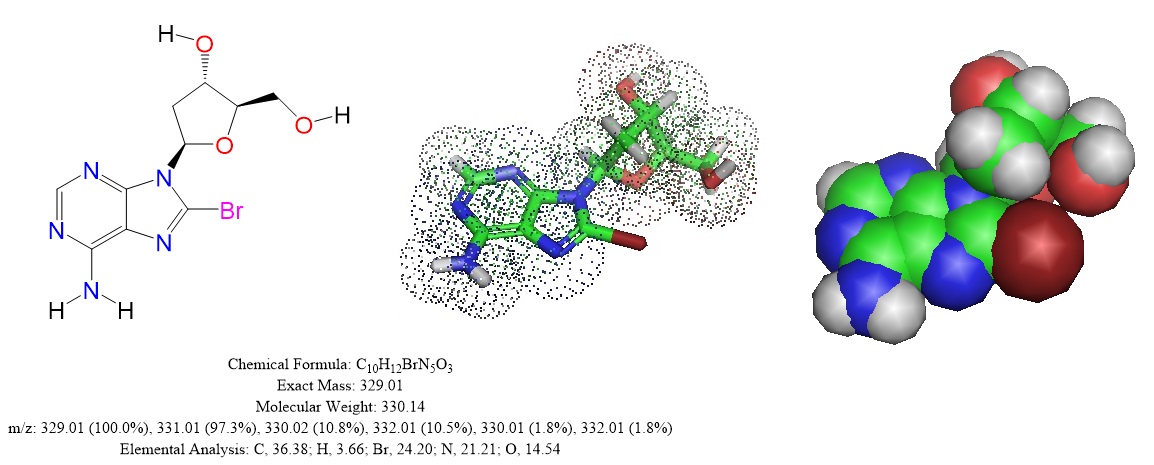8-Bromo-2'-deoxyadenosine, 8-Br-dA, Mw 330.14 g/mol , CAS 14985-44-5, (2R,3S,5R)-5-(6-Amino-8-bromo-9H-purin-9-yl)-2-(hydroxymethyl)tetrahydrofuran-3-ol.
The organobromine compound 8-bromo-2’-deoxyadenosine is a modified 2’-deoxyadenosine having a bromo substituent at position 8 of the adenosine ring system and a member of adenosines.

Similar to 8-Br-dG, 8-Br-dA is a useful molecule for crystallography based structural studies of oligonucleotides. Brominated as well as iodinated nucleosides are photolabile. This feature makes them ideal candidates for cross-linking studies as well.
The photo-active 8-Br-dA can be incorporated into oligonucleotides as a phosphoramidite during automated oligonucleotide synthesis. Photolytic cleavage of the C–Br bond leads to formation of the C8 radical. In aqueous conditions, the major reaction path generates a C5′ radical. The C5′ radical undergoes a cyclization reaction on the adenine, resulting in an aminyl radical with a rate constant of 1.8 × 105 s−1. Steady-state photolysis studies in acetonitrile showed the conversion of 8-bromo-2′-deoxyadenosine to 5′,8-cyclo-2′-deoxyadenosine with a 65% yield and a diastereoisomeric ratio (5′R) ∶ (5′S) = 1.7.
8-bromoadenine present in DNA or RNA oligonucleotides can react with thiols under physiological conditions forming adducts. This reaction can be utilized to generate specific thiol modified oligonucleotides.
When tissues are inflamed, cellular DNA is damaged by hypobromous acid (Br-OH). Br-OH is generated by myeloperoxidase and eosinophil peroxidase.
Reference
JiaLiu, Gregory LVerdin∗; Synthesis of photoactive DNA: incorporation of 8-bromo-2′-deoxyadenosine into synthetic oligodeoxynucleotides. Tetrahedron Letters. Volume 33, Issue 30, 21 July 1992, Pages 4265-4268. [link]
Liliana B. Jimenez, Susana Encinas, Miguel A. Miranda, Maria Luisa Navacchia and Chryssostomos Chatgilialoglu; The photochemistry of 8-bromo-2′-deoxyadenosine. A direct entry to cyclopurine lesions. Photochemical & Photobiological Sciences. Issue 11-12, 2004 Photochem. Photobiol. Sci., 2004,3, 1042-1046. [link]
Mayeno, AN; Curran, AJ; Roberts, RL; Foote, CS (1989). "Eosinophils preferentially use bromide to generate halogenating agents". The Journal of Biological Chemistry. 264 (10): 5660–8. PMID 2538427. Retrieved 2008-01-12. [jbc]
Sassa A, Ohta T, Nohmi T, Honma M, Yasui M.; Mutational specificities of brominated DNA adducts catalyzed by human DNA polymerases. J Mol Biol. 2011 Mar 11;406(5):679-86. doi: 10.1016/j.jmb.2011.01.005. Epub 2011 Jan 15. [Pubmed]
---...---